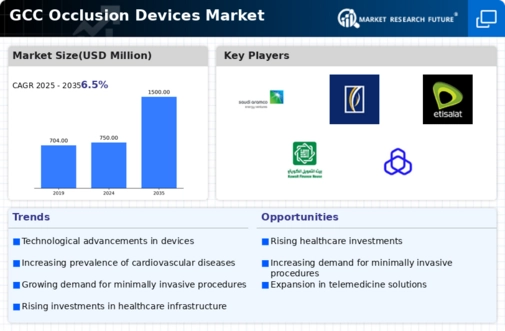Rising Geriatric Population
The increasing geriatric population in the GCC is a significant factor driving the occlusion devices market. As individuals age, they become more susceptible to cardiovascular diseases, necessitating the use of occlusion devices for effective management. The demographic shift towards an older population is prompting healthcare systems to adapt and provide specialized care tailored to the needs of elderly patients. This trend is likely to result in a higher demand for occlusion devices, as they are essential in treating age-related cardiovascular conditions. The occlusion devices market is expected to grow in response to this demographic change, as healthcare providers seek to implement solutions that cater to the unique challenges posed by an aging population.
Expansion of Healthcare Infrastructure
The expansion of healthcare infrastructure in the GCC is a critical driver for the occlusion devices market. Governments in the region are investing heavily in healthcare facilities, aiming to enhance service delivery and accessibility. This expansion includes the establishment of specialized cardiac care centers equipped with advanced medical technologies. As a result, the availability of occlusion devices is expected to increase, facilitating their adoption in clinical practice. The occlusion devices market stands to benefit from this trend, as improved infrastructure supports the implementation of innovative treatment options. Additionally, the growing number of healthcare professionals trained in the use of these devices will likely enhance patient care and outcomes.
Growing Awareness of Preventive Healthcare
There is a notable increase in awareness regarding preventive healthcare in the GCC, which is positively impacting the occlusion devices market. Patients are becoming more informed about the risks associated with untreated cardiovascular conditions, leading to a higher demand for preventive measures. This shift in patient behavior encourages healthcare providers to adopt occlusion devices as part of their treatment protocols. The occlusion devices market is likely to see a surge in demand as more individuals seek early intervention strategies to mitigate health risks. Furthermore, public health campaigns aimed at educating the population about cardiovascular health are expected to contribute to this trend, fostering a culture of proactive healthcare.
Technological Innovations in Medical Devices
Technological advancements in medical devices are significantly influencing the occlusion devices market. Innovations such as bioresorbable occlusion devices and advanced imaging techniques enhance the efficacy and safety of procedures. The integration of artificial intelligence and machine learning in device design and patient monitoring systems is also gaining traction. These innovations not only improve procedural outcomes but also reduce recovery times, making them attractive to both healthcare providers and patients. The occlusion devices market is expected to benefit from these advancements, as they align with the increasing demand for efficient and effective medical solutions. As a result, investment in research and development is likely to rise, further driving market growth.
Increasing Prevalence of Cardiovascular Diseases
The rising incidence of cardiovascular diseases in the GCC region is a primary driver for the occlusion devices market. As lifestyle-related health issues become more prevalent, healthcare providers are increasingly adopting occlusion devices to manage conditions such as atrial fibrillation and coronary artery disease. According to recent health statistics, cardiovascular diseases account for approximately 40% of all deaths in the GCC, highlighting the urgent need for effective treatment options. This growing health crisis is likely to propel the demand for occlusion devices, as they play a crucial role in preventing complications associated with these diseases. The occlusion devices market is thus positioned for growth, as healthcare systems invest in advanced technologies to improve patient outcomes and reduce healthcare costs.

















Leave a Comment